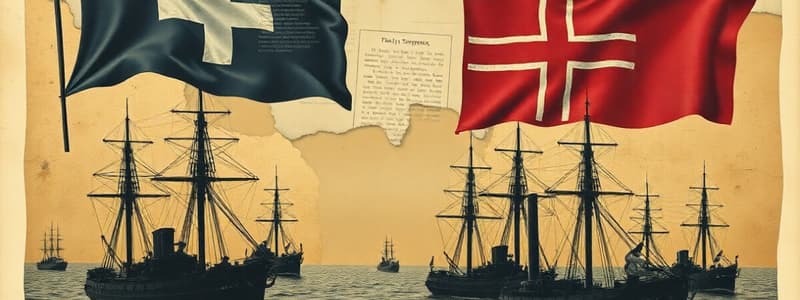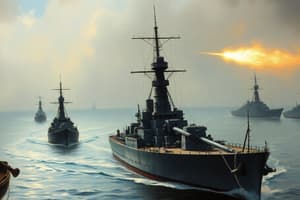Podcast
Questions and Answers
What does 'striking the flag' generally signify?
What does 'striking the flag' generally signify?
- A declaration of war.
- A sign of surrender. (correct)
- A change in command.
- A call for reinforcements.
What is generally expected once a ship has struck its flag?
What is generally expected once a ship has struck its flag?
- Negotiations for peace begin immediately.
- The opposing side should cease fire. (correct)
- Both sides must retreat to assess damages.
- The surrendered crew becomes prisoners of war.
Which Confederate ship was involved in a conflict off the coast of Cherbourg, France?
Which Confederate ship was involved in a conflict off the coast of Cherbourg, France?
- USS Philadelphia
- C.S.S. Alabama (correct)
- USS Constitution
- HMS Guerriere
Who was the commanding officer of the C.S.S. Alabama during its engagement off the coast of Cherbourg?
Who was the commanding officer of the C.S.S. Alabama during its engagement off the coast of Cherbourg?
What ship challenged Captain Semmes account of the battle?
What ship challenged Captain Semmes account of the battle?
Flashcards
Striking the Flag
Striking the Flag
A universal sign of surrender in naval warfare.
Post-Surrender Conduct
Post-Surrender Conduct
After a ship lowers its flag, continuing to attack violates international norms.
Raphael Semmes
Raphael Semmes
Commanding officer of the Confederate ship C.S.S. Alabama.
USS Kearsarge
USS Kearsarge
Signup and view all the flashcards
John Winslow
John Winslow
Signup and view all the flashcards
Study Notes
- Striking the flag, also termed striking the colors, universally signals surrender.
- International standards consider it a breach to continue engaging a surrendered ship once its flag is lowered.
- Despite the custom, the heat of battle can sometimes disrupt accepted practices.
- On June 18, 1864, Kearsarge battled the Confederate ship C.S.S. Alabama off Cherbourg, France.
- Captain Raphael Semmes, the commanding officer of the Alabama, recounted that Kearsarge continued firing even after the Alabama had lowered its flag.
- Captain John Winslow of the Kearsarge disputed this, claiming the Alabama continued to fire.
- Image shows the Action between USS Constitution and HMS Guerriere, 19 August 1812, where the British frigate strikes its flag in surrender.
- Image shows "Hauling Down the Flag -- Surrender of the Alabama to the Kearsarge off Cherbourg, France, 19 June 1864"
- Image shows Engagement between USS Chesapeake and HMS Shannon, 1 June 1813, depicting Chesapeake striking its flag to Shannon.
Studying That Suits You
Use AI to generate personalized quizzes and flashcards to suit your learning preferences.
Related Documents
Description
Striking the flag is a universal signal of surrender in naval warfare. International standards dictate that a surrendered ship should not be engaged after its flag is lowered. Instances like the Kearsarge-Alabama battle highlight disputes over adherence to this custom during conflict.




